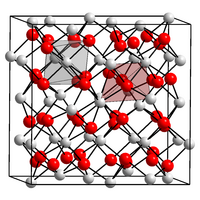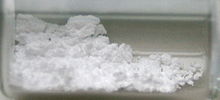Europium (III) oxide
| Crystal structure | ||||||||||||||||
|---|---|---|---|---|---|---|---|---|---|---|---|---|---|---|---|---|

|
||||||||||||||||
| __ Eu 3+ __ O 2− | ||||||||||||||||
| General | ||||||||||||||||
| Surname | Europium (III) oxide | |||||||||||||||
| other names |
Europium sesquioxide |
|||||||||||||||
| Ratio formula | Eu 2 O 3 | |||||||||||||||
| Brief description |
white to light pink odorless solid |
|||||||||||||||
| External identifiers / databases | ||||||||||||||||
|
||||||||||||||||
| properties | ||||||||||||||||
| Molar mass | 351.92 g mol −1 | |||||||||||||||
| Physical state |
firmly |
|||||||||||||||
| density |
7.42 g cm −3 |
|||||||||||||||
| Melting point |
2291 ° C |
|||||||||||||||
| boiling point |
4118 ° C |
|||||||||||||||
| solubility |
practically insoluble in water |
|||||||||||||||
| safety instructions | ||||||||||||||||
|
||||||||||||||||
| Toxicological data | ||||||||||||||||
| As far as possible and customary, SI units are used. Unless otherwise noted, the data given apply to standard conditions . | ||||||||||||||||
Europium (III) oxide is a chemical compound from the group of oxides of europium .
Extraction and presentation
After the laborious separation of the other lanthanoids from their ores, europium (III) oxalate Eu 2 (C 2 O 4 ) 3 · 10 H 2 O is finally obtained, which is then burned to form europium oxide Eu 2 O 3 .
In order to obtain nanocrystals of the material, synthesis by calcination of the corresponding hydroxide or oxalate is used.
properties
Europium (III) oxide is a hygroscopic white to light pink odorless solid that is practically insoluble in water. It has a monoclinic crystal structure.
use
In long-wave UV light it glows intensely red and is therefore mainly used as a security color on banknotes. Europium (II) silicate can be produced by reducing europium (III) oxide with elemental europium and silicon dioxide at 1100 ° C.
Individual evidence
- ↑ a b c d e f g h Entry for CAS no. 1308-96-9 in the GESTIS substance database of the IFA , accessed on January 25, 2012(JavaScript required) .
- ↑ a b Datasheet Europium (III) oxide, 99.999% trace metals basis from Sigma-Aldrich , accessed on January 25, 2012 ( PDF ).
- ↑ a b Ginya Adachi, Nobuhito Imanaka, Zhen Chuan Kang: Binary rare earth oxides. 2004, Springer Netherlands, ISBN 978-1-4020-2568-6 , p. 138 ( limited preview in Google book search).
- ↑ Seilnacht: Europium
- ↑ didactic chemistry: transition metal oxides as color pigments
- ↑ C. Funk, J. Köhler, I. Lazar, D. Kajewski, K. Roleder, J. Nuss, A. Bussmann-Holder, H. Bamberger, J. van Slageren, D. Enseling, T. Jüstel, T. Schleid, Cryst. Growth Des . 2018 , 18 , 6316-6325. doi: 10.1021 / acs.cgd.8b01265


